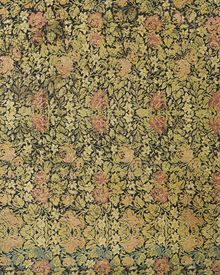Difference between revisions of "Ukrainian Carpet"
| (6 intermediate revisions by 2 users not shown) | |||
| Line 1: | Line 1: | ||
{{Infobox Rug and Carpet | {{Infobox Rug and Carpet | ||
|above = | |above = | ||
| − | |image = | + | |image = [[File:Ukrainian Carpet-WikiRug.jpg|frameless|220px]] |
|caption = | |caption = | ||
| Line 9: | Line 9: | ||
<!--General information--> | <!--General information--> | ||
| − | |Name = | + | |Name = Ukrainian Carpet |
|Original name = فرش اوکراین، قالی اوکراین | |Original name = فرش اوکراین، قالی اوکراین | ||
| − | |Alternative names = | + | |Alternative names = Ukrainian Rug |
| − | |Origin = | + | |Origin = {{flag|Ukraine}} |
|Category = | |Category = | ||
|Prime examples = | |Prime examples = | ||
| Line 26: | Line 26: | ||
|Common colors = | |Common colors = | ||
|Dyeing method = | |Dyeing method = | ||
| − | |Pile material = | + | |Pile material = [[Wool]] |
| − | |Foundation material = | + | |Foundation material = [[Cotton]] |
|Weaving Technique = | |Weaving Technique = | ||
| − | |Knot type = | + | |Knot type = [[Symmetrical Knot|Symmetrical]] (Turkish) |
|Knot density = | |Knot density = | ||
| Line 47: | Line 47: | ||
==Bibliography== | ==Bibliography== | ||
* Abraham Levi Moheban. 2015. ''The Encyclopedia of Antique Carpets: Twenty-Five Centuries of Weaving''. NewYork: Princeton Architectural Press. | * Abraham Levi Moheban. 2015. ''The Encyclopedia of Antique Carpets: Twenty-Five Centuries of Weaving''. NewYork: Princeton Architectural Press. | ||
| − | * Peter F. Stone. 2013. ''Oriental Rugs: An Illustrated Lexicon of Motifs, Materials, and Origins''. North Clarendon :Tuttle | + | * Peter F. Stone. 2013. ''Oriental Rugs: An Illustrated Lexicon of Motifs, Materials, and Origins''. North Clarendon: Tuttle. |
| − | [[Category: | + | {{Template:Worlds Carpets}} |
| + | [[Category:Worlds Carpets]] | ||
[[fa:فرش اوکراین]] | [[fa:فرش اوکراین]] | ||
Latest revision as of 11:47, 14 September 2020
| Ukrainian Carpet | |
|---|---|
 | |
| General information | |
| Name | Ukrainian Carpet |
| Original name | فرش اوکراین، قالی اوکراین |
| Alternative name(s) | Ukrainian Rug |
| Origin | |
| Technical information | |
| Pile material | Wool |
| Foundation material | Cotton |
| Knot type | Symmetrical (Turkish) |
Ukrainian Carpet or Ukrainian Rug is one of the western rugs that woven in Ukraine.
Formerly the Ukrainian Soviet Socialist Republic, lies south and west of Russia, bordering the Black Sea. Pile rugs have been woven in manor houses and factories in the Ukraine since the seventeenth century. Floral motifs, possibly derived from Savonnerie models, are typical of early pile rug production. Pile rugs were woven in weaving cooperatives or artels after the Russian revolution. Tapestry woven kilims in geometric and floral designs were produced, some with Cyrillic inscriptions. The Ukraine is best known for elaborate embroidery work. As a folk craft, embroidery was used extensively on garments, bedclothes, curtains, and furniture coverings. Much of this embroidery comes from the Poltava and Kiev regions.[1]
History
Ukraine is a country located north of the Black Sea in central Eastern Europe. In the ninth century CE, Ukraine was occupied by the Varangians, a Nordic Viking army that unified various tribes scattered throughout the territory. Under the leadership of Vladimir I (956-1015), the Varangians established close ties with the Byzantine Empire and adopted Christianity in the territory in 988 CE. The Varangians were overthrown by the fourteenth century, however, and for several centuries the Ukraine territory was occupied by different foreign armies, including the Tatars, the Kingdom of Poland, Lithuania, Sweden, Tsarist Russia, and the Austro-Hungarian Empire. Ukraine would gain its independence from the Soviet Union after the Cold War in 1991.
Ukraine weavings dating from the late eighteenth century are known in the antique market. The carpets are floral and were inspired by European designs, notably the French Louis-Philippe Carpets style. Many of the designs and colors woven in Ukraine bear similarities to those of the neighboring weaving region of Bessarabia. It is believed that the Ukrainian and Bessarabian workshops were connected by both art and commerce. Both territories produce English Needlepoint, paisley Shawls, and Lattice patterns. Carpet backgrounds, as well as borders and medallions, are mostly black or grayish black. Pomegranate-red (from cochineal) and ivory are incorporated with the black coloration, which creates an attractive appearance. Different shades of green, gold, gray, brown, beige, and cinnamon are used for the design motifs and outlines. For decades, the Ukrainian color palette has been in demand by interior designers worldwide.
Ukrainian carpets have a cotton foundation and a wool pile. The Turkish (symmetric) knot is employed. They were made in dimensions ranging from small room sizes to dining room sizes. The carpets were woven on a limited scale in workshops, and production stopped after the Soviet Union annexation in the 1920s. Today, early Ukrainian weavings are attractive to consumers and designers, and can bring high prices in the open market.[2]
References
Bibliography
- Abraham Levi Moheban. 2015. The Encyclopedia of Antique Carpets: Twenty-Five Centuries of Weaving. NewYork: Princeton Architectural Press.
- Peter F. Stone. 2013. Oriental Rugs: An Illustrated Lexicon of Motifs, Materials, and Origins. North Clarendon: Tuttle.